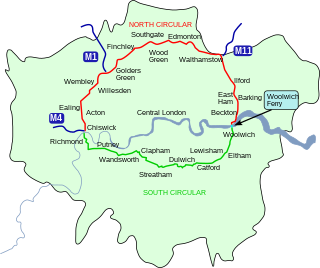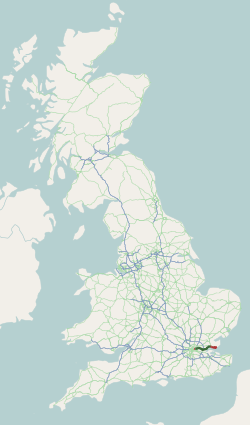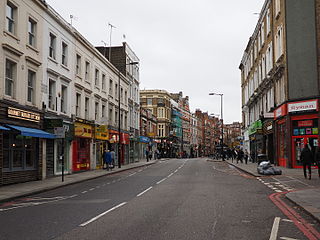Route
The NCR would have started in Harlesden with its western end having a junction to the east of Willesden Junction station with the West Cross Route, the western section of Ringway 1 coming north from Shepherd's Bush. Also connected to the junction here would have been Harrow Road (A404) and a spur from the NCR would have connected to the Western Avenue (A40) near Gypsy Corner.
Heading east, the NCR would have run in a cutting along the north side of the North London Line to Brondesbury and Kilburn High Road (A5). To accommodate the motorway cutting, most of the houses on the south side of the roads lining the railway would have been demolished. Roads that crossed the railway line, such as Willesden Lane, would have also bridged the sunken motorway.
Between Kilburn High Road and West End Lane a major Y-shaped junction would have been constructed where the NCR was to meet the intended end of the M1 motorway. This was originally planned to be continued south of its Staples Corner junction with the North Circular Road (Ringway 2) along the east side of the Midland Main Line through Cricklewood. The M1 junction would have been provided with slip roads allowing traffic movements between the M1 and NCR in each direction and the NCR would also have been provided with additional lanes between this junction and a roundabout to have been built at Finchley Road (A41) between Finchley Road and Finchley Road & Frognall stations.
East of Finchley Road there were three alternative routes towards Camden Town:
- The NCR would have entered a cut-and-cover tunnel heading south-west through the western part of Belsize Park before returning into open air south of Eton Avenue and then crossing over Adelaide Road to follow the West Coast Main Line the short distance to Chalk Farm then crossing above a British Rail goods yard there and heading east along the railway to central Camden Town to rejoin the North London Line.
- The NCR would have continued to follow the North London Line through Gospel Oak and then south through Kentish Town to Camden Town.
- The NCR would have continued to follow the North London Line to Gospel Oak but switched there to follow the Midland Main Line to avoid central Camden Town and rejoin the North London line near York Way.
Despite the destruction involved in constructing the tunnel through Belsize Park, the preferred route appears to have been alternative 1 as this provided the best means of creating an interchange with the planned Camden Town by-pass which would have connected Albany Street (south-west of Camden Town) to Camden Road (north-east of Camden Town).
East of Camden Town, the NCR would have continued to follow the north side of the North London Line to Caledonian Road (A5203), where another junction would have been provided, then through Highbury and Canonbury to Dalston where the NCR would have passed over Kingsland High Street (A10) and along Ridley Road Market before a further junction would have been built to connect to the High Street and Dalston Lane. The final section of the NCR would have crossed through Hackney town centre parallel with the railway viaduct, passing south of 16th century Sutton House, East London's oldest house, and on through Homerton and Hackney Wick where it would have interchanged with the East Cross Route coming north from Bow, the proposed M11 motorway coming south-west from Leyton and a motorway heading south-west towards Angel. To facilitate this complex junction the North London line was diverted to a new route through Hackney Wick.

The M25 or London Orbital Motorway is a major road encircling most of Greater London. The 117-mile (188-kilometre) motorway is one of the most important roads in the UK and one of the busiest. Margaret Thatcher opened the final section in 1986, making the M25 the longest ring road in Europe upon opening. The Dartford Crossing completes the orbital route but is not classed as motorway; it is classed as a trunk road and designated as the A282. In some cases, including notable legal contexts such as the Communications Act 2003, the M25 is used as a de facto alternative boundary for Greater London.

The M11 is a 55 miles (89 km) motorway that runs north from the North Circular Road (A406) in South Woodford to the A14, northwest of Cambridge, England. Originally proposed as a trunk road as early as 1915, various plans were considered throughout the 1960s, with final construction being undertaken between 1975 and 1980. The motorway was opened in stages, with the first stage between junctions 7 and 8 opening in June 1975, and the completed motorway becoming fully operational in February 1980. Running from Woodford to Girton, the motorway provides direct access to Harlow, Cambridge and since 2002, greatly improved access to London Stansted Airport.

The London Inner Ring Road, or Ring Road as signposted, is a 12-mile (19 km) route with an average diameter of 2.75–5.5 miles (4.43–8.85 km) formed from a number of major roads that encircle Central London. The ring road forms the boundary of the London congestion charge zone, although the ring road itself is not part of the zone.

The North London line (NLL) is a railway line which passes through the inner suburbs of west, north-west, north, and east London, England between Richmond in the south-west and Stratford in the east, avoiding central London. Its route is a rough semicircle.

The Westway is a 2.5-mile (4 km) elevated dual carriageway section of the A40 trunk road in West London running from Paddington in the east to North Kensington in the west. It connects the London Inner Ring Road to the West London suburbs.

The M23 is a motorway in the United Kingdom, running from the south of Hooley in Surrey, where it splits from the A23, to Pease Pottage, south of Crawley in West Sussex where it rejoins the A23. The northern end of the motorway starts on what is effectively a 2-mile (3.2 km) spur north of junction 7 of the M25 motorway. From Hooley it runs for 17 miles (27 km) past Redhill, Gatwick Airport and Crawley. A spur runs from junction 9 to Gatwick Airport.

The A12 is a major road in Eastern England. It runs north-east/south-west between London and the coastal town of Lowestoft in the north-eastern corner of Suffolk, following a similar route to the Great Eastern Main Line until Ipswich. A section of the road between Lowestoft and Great Yarmouth became part of the A47 in 2017. Between the junctions with the M25 and the A14, the A12 forms part of the unsigned Euroroute E30. Unlike most A roads, this section of the A12, together with the A14 and the A55, has junction numbers as if it were a motorway.

The North Circular Road is a 25.7-mile-long (41.4 km) ring road around Central London in England. It runs from Chiswick in the west to Woolwich in the east via suburban North London, connecting various suburbs and other trunk roads in the region. Together with its counterpart, the South Circular Road, it forms a ring road around central London. This ring road does not make a complete circuit of the city, being C-shaped rather than a complete loop as the crossing of the River Thames in the east is made on the Woolwich Ferry.

The A13 is a major road in England linking Central London with east London and south Essex. Its route is similar to that of the London, Tilbury and Southend line via Rainham, Grays, Tilbury, Stanford-Le-Hope & Pitsea,and runs the entire length of the northern Thames Gateway area, terminating on the Thames Estuary at Shoeburyness. It is a trunk road between London and the Tilbury junction, a primary route between there and Sadlers Hall Farm near South Benfleet, and a non-primary route between there and Shoeburyness.

Staples Corner is a major road junction in London, United Kingdom. It is about 6.3 miles (10.1 km) north-west from Charing Cross and directly to the west of the Brent Cross crossover.

The West Cross Route (WCR) is a 0.75 mile segment of dual carriageway of the A3220 route in West London running north–south between the northern elevated roundabout junction with the western end of Westway (A40) and the southern Holland Park Roundabout. It runs through Shepherd's Bush to its west and Notting Hill to its east.

East Cross Route (ECR) is a dual-carriageway road constructed in east London as part of the uncompleted Ringway 1 as part of the London Ringways plan drawn up the 1960s to create a series of high speed roads circling and radiating out from central London. The road was constructed between 1967 and 1973 and runs from Hackney Wick in north-east London, through the Blackwall Tunnel, to Kidbrooke in south-east London. The ECR was initially designated as part of the A102, but has, subsequently, been partially renumbered so that sections of it are now the A2 and A12.

The London Ringways were a series of four ring roads planned in the 1960s to circle London at various distances from the city centre. They were part of a comprehensive scheme developed by the Greater London Council (GLC) to alleviate traffic congestion on the city's road system by providing high speed motorway-standard roads within the capital, linking a series of radial roads taking traffic into and out of the city.

The A102 is a road that starts in Clapton, east London, and ends by merging into the A2 road just south of the Sun in the Sands roundabout in Blackheath, south-east London. The A102 was formerly a continuous route including two motorway sections classified as the A102(M), but road renumbering means that it is separated into two sections linked by the A106 and the A12, one consisting of non-primary urban roads and the other a primary dual carriageway south of the river. The route includes the Blackwall Tunnel.
South Cross Route (SCR) was the designation for the southern section of Ringway 1, the innermost circuit of the London Ringways network, a complex and comprehensive plan for a network of high speed roads circling and radiating out from central London designed to manage and control the flow of traffic within the capital.

The M12 motorway was a planned motorway starting in north-east London and joining the A12 road in Essex. The 1960s scheme would have started at a junction with the M11 motorway and North Circular and ended near Brentwood, Chelmsford, or at the proposed new Maplin Sands airport; the motorway was part of the ambitious London Ringways plan to build motorways throughout London. Although most of the Ringways plan was cancelled in 1969 the M12 motorway project was still included in the Roads for Prosperity white paper published in 1989 along with major proposed developments to the A12 road. It was not formally cancelled until 30 March 1994 by the Secretary of State for Transport, John MacGregor.

The A3220 is a primary A road in London, England. It runs north from Clapham Common to the A40 Westway at Ladbroke Grove.

National Cycle Route 1 is a route of the National Cycle Network, running from Dover to Tain. The 1,264 mi-long (2,034-kilometre) cycle-path is located in the United Kingdom.

The A40 is a major trunk road connecting London to Fishguard, Wales. The A40 in London passes through seven London Boroughs: the City of London, Camden, Westminster, Kensington & Chelsea, Hammersmith & Fulham, Ealing and Hillingdon, to meet the M40 motorway junction 1 at Denham, Buckinghamshire.


















